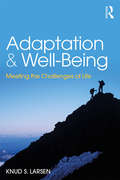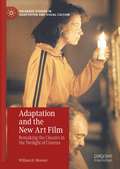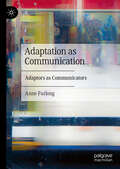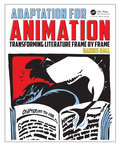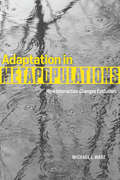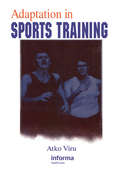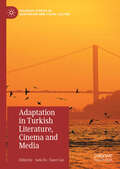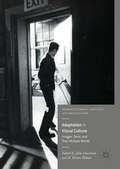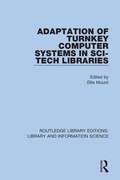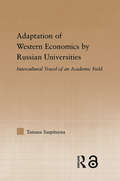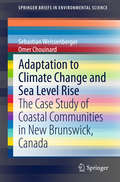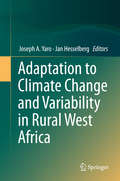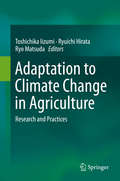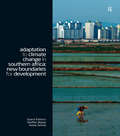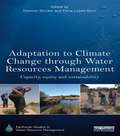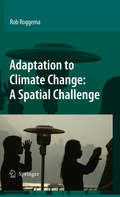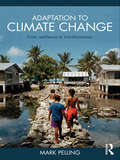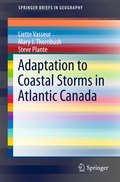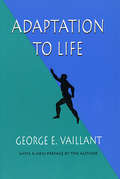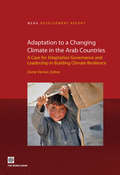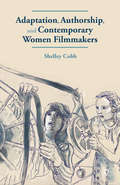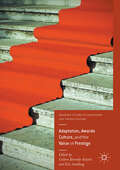- Table View
- List View
Adaptation and Well-Being: Meeting the Challenges of Life
by Knud S Larsen"According to Leo Tolstoy’s famous statement "all happy families are alike, each unhappy family is unhappy in its own way". Knud Larsen in his book on human happines proves the opposite. Summarizing the classical and recent research in successful human adaptation, adjustment and well-being of the soul and body he shows the many faces of individual human happiness. Moreover, the book opens the perspective into the directions of social, cultural and biological evolution. What I like most in the book, is its usefulness. Knud has many practical pieces of advice suggesting that we can improve our well-being if we try. I wish Anna Karenina had read this well-conceived, well written text.", Gyorgy Csepeli, Professor of Social Psychology, Chair of the Interdisciplinary Social Research Program of the Doctoral School of the Faculty of Social Science at ELTE, Senior Research Fellow of the Institute of Advanced Studies at Kőszeg (iASK) "This unique, reader-friendly volume covers psychological aspects of successful living with such diversity and depth that I have not encountered hitherto. It is essential reading for psychology undergraduates as well as more seasoned academics and practitioners", Howie Giles, Distinguished Professor Communication, University of California, Santa Barbara, USA & Honorary Professor of Psychology, University of Queensland, Australia "This book by Professor Larsen is very enjoyable reading and covers the many challenges humans face across the lifespan. The focus is on positive psychology as supportive solutions are offered for the many challenges of living. This is also a relatively rare book that evaluates adaptation from a socio-cultural perspective since most books today emphasize cognitive aspects of coping and development. I especially appreciated how Professor Larsen weaved his salient knowledge of cross-cultural psychology into this important work on human adaptation. In the book the author discusses the issue of adaptation in its varying aspects of human life and through the prism of cultural influence on personality and behavior.", Askar Jumageldinov, Ph.D, Assistant Professor at Catholic University in Lyon "This book uniquely ties together the author’s personal experiences with in-depth research on human adaptation. What strikes the reader is the very personal narrative that illustrates the many points of struggling with the challenges of being human. The book combines the best of classical literature along with very current and meaningful research. The whole human journey is evaluated from identity and finding meaning, through optimizing health in midlife to facing the final existential questions related to both death and longevity. A very thoughtful book.", Sven Morch, Ph.D , Professor, University of Copenhagen "An enlightened and enlightening story of the challenges we meet through our life course. Although the general reader may find useful information to the journey of life it is also a volume packed with research-based information from the psychological and social sciences with implications for how we can grow as human beings and live satisfying lives together.", Reidar Ommundsen, Professor Emeritus, University of Oslo "I have found the work of Knud Larsen to dove-tail with my own work on behalf of indigenous and third world peoples since I first became acquainted with him in the context of supporting the People of Cuba. Dr. Larsen, as manifest in this career-capping work, has the ability – rare among non-ethnologist academics – to be engaged in the inner cognitive world of people inside other cultures while viewing their society in his own unique perspective. This broad and deep treatment will deepen and broaden my own view of the peoples that I have engaged with on the cognitive level. It also broadens my view of the challenges of my own life and how to live a happy life.", John Allison, Cognitive ethnologist and author
Adaptation and the New Art Film: Remaking the Classics in the Twilight of Cinema (Palgrave Studies in Adaptation and Visual Culture)
by William H. MooneySince the 1990s, the expropriation of canonical works of cinema has been a fundamental dimension of art-film exploration. Rainer Werner Fassbinder provides an early model of open adaptation of film classics, followed ever more boldly by the Coen Brothers, Chantal Akerman, Alex Carax, Todd Haynes, Florian Henckel von Donnersmarck, Baz Luhrmann, and Olivier Assayas. This book devotes chapters to each of these directors to examine how their films redeploy landmark precursors such as City Lights (1931), Citizen Kane (1941), Rome Open City (1945), All About Eve (1950), and Vertigo (1958) in order to probe our psychological, philosophical, and historical situations in a postmodern société du spectacle. In broadly diverse ways, each of these directors complicates received notions of the past and its representation, while probing the transformative media evolution and dislocation of the present, in film art and in society.
Adaptation as Communication: Adaptors as Communicators
by Anne FurlongThis book offers a consistent, theoretically grounded, accessible account of adaptation across a range of instances, employing Relevance Theory as its explanatory framework and arguing that every adaptation is an independent communicative act. The author establishes the principles of the study in the first part, introducing and contextualising the theory developed by Sperber and Wilson, before going on in the second part to demonstrate the strength of the approach, and its relevance and utility within adaptation studies and beyond through a wide array of examples. The volume will open up discussion in areas previously underserved by adaptation studies and consider broader implications, such as where we draw the line when we think about 'adaptation'. This book will be of interest to students and scholars in a range of fields including adaptation studies, relevance theory, linguistic pragmatics, stylistics, narratology, intertextuality, literature and film studies.
Adaptation for Animation: Transforming Literature Frame by Frame
by Hannes RallTalented animation artists often neglect successful storytelling in favor of strong visuals, but now you can have both with this complete guide to adaptation for animation. Veteran independent filmmaker Hannes Rall teaches you how to draw and adapt inspiration from copyright-free materials like fairy tales, myths, and classic literature, making it easier than ever to create your own compelling narrative. Particular focus is given to making the adequate narrative and visual choices when transferring a text from page to screen: How to create a successful adaptation. With sections on subjects like transcultural adaptations, visual poetry and production design, this book is just the right mix of practical advice, lavish illustrations, and industry case studies to give you everything you need to start adapting your story today. Key features: Learn to apply concepts of adapting classic and modern literature for animation in different techniques Exclusive interviews with animation legends Giannalberto Bendazzi, John Canemaker, Ishu Patel and Georges Schwizgebel Lavishly illustrated with 325 color images (mostly never published before) that give thrilling insights into the visual development of award-winning animated adaptations
Adaptation in Metapopulations: How Interaction Changes Evolution
by Michael J. WadeAll organisms live in clusters, but such fractured local populations, or demes, nonetheless maintain connectivity with one another by some amount of gene flow between them. Most such metapopulations occur naturally, like clusters of amphibians in vernal ponds or baboon troops spread across the African veldt. Others have been created as human activities fragment natural landscapes, as in stands of trees separated by roads. As landscape change has accelerated, understanding how these metapopulations function—and specifically how they adapt—has become crucial to ecology and to our very understanding of evolution itself. With Adaptation in Metapopulations, Michael J. Wade explores a key component of this new understanding of evolution: interaction. Synthesizing decades of work in the lab and in the field in a book both empirically grounded and underpinned by a strong conceptual framework, Wade looks at the role of interaction across scales from gene selection to selection at the level of individuals, kin, and groups. In so doing, he integrates molecular and organismal biology to reveal the true complexities of evolutionary dynamics from genes to metapopulations.
Adaptation in Sports Training
by Atko ViruFounded on an analysis of scientific literature and backed by an abundance of references, this timely new book examines problems related to sports training, as well as the concept that training-induced changes are founded on adaptive protein synthesis. Discussions include:Alterations in the organism's adaptivity during exercise trainingIntracellular control of protein synthesis points on molecular mechanisms in exercise trainingEndocrine mechanisms with regard to acute adaptation during exercise, as well as amplification and post-translation control of the adaptive protein synthesisPractical benefits of the adaptation process in training
Adaptation in Turkish Literature, Cinema and Media (Palgrave Studies in Adaptation and Visual Culture)
by Taner Can Seda ÖzThis edited collection provides a comprehensive exploration of key trends and methodologies in adaptation within the Turkish context, examining how socio-political and economic conditions shape the interaction between texts, cultures, and media industries. With thirteen essays covering adaptation topics from the early 1940s to the present, the collection addresses a diverse range of subjects, including novel-to-film adaptations, film remakes, television series, documentary dramas, stage adaptations, comic books, and the music industry.
Adaptation in Visual Culture: Images, Texts, and Their Multiple Worlds (Palgrave Studies in Adaptation and Visual Culture)
by R. Barton Palmer Julie GrossmanThis book offers the first comprehensive discussion of the relationship between Modern Irish Literature and the Irish cinema, with twelve chapters written by experts in the field that deal with principal films, authors, and directors. This survey outlines the influence of screen adaptation of important texts from the national literature on the construction of an Irish cinema, many of whose films because of cultural constraints were produced and exhibited outside the country until very recently. Authors discussed include George Bernard Shaw, Oscar Wilde, Liam O'Flaherty, Christy Brown, Edna O'Brien, James Joyce, and Brian Friel. The films analysed in this volume include THE QUIET MAN, THE INFORMER, MAJOR BARBARA, THE GIRL WITH GREEN EYES, MY LEFT FOOT, THE PICTURE OF DORIAN GRAY, THE SNAPPER, and DANCING AT LUGHNASA. The introduction features a detailed discussion of the cultural and political questions raised by the promotion of forms of national identity by Ireland's literary and cinematic establishments.
Adaptation of Turnkey Computer Systems in Sci-Tech Libraries (Routledge Library Editions: Library and Information Science #6)
by Ellis MountThis book, first published in 1989, examines the problems and benefits of installing a ready-made computer system in a sci-tech library. These systems, usually known as turnkey systems, provide a means for obtaining the network for a lower cost than a new system designed by a consultant. These papers analyse the benefits and problems with turnkey systems in a variety of different situations.
Adaptation of Western Economics by Russian Universities: Intercultural Travel of an Academic Field (Studies In Higher Education)
by Tatiana SuspitsynaFirst published in 2005. Routledge is an imprint of Taylor & Francis, an informa company.
Adaptation to Climate Change and Sea Level Rise: The Case Study of Coastal Communities in New Brunswick, Canada (SpringerBriefs in Environmental Science)
by Sebastian Weissenberger Omer ChouinardThe book provides a concise and interdisciplinary outlook on the impacts of climate change on coastal areas and how coastal communities adapt to them. The first chapter analyses how sea level rise, changing ocean conditions, or increased climate variability and the socio-environmental context of the coastal zone leads to vulnerable communities. The second chapter addresses adaptation strategies and tools, and gives some examples of their application around the world. The third chapter describes participative action research projects undertaken in New Brunswick and how this community based approach has enabled communities to increase their climate resilience.
Adaptation to Climate Change and Variability in Rural West Africa
by Joseph A. Yaro Jan HesselbergThis book presents conceptual and empirical discussions of adaptation to climate change/variability in West Africa. Highlighting different countries' experiences in adaptation by different socio-economic groups and efforts at building their adaptive capacity, it offers readers a holistic understanding of adaptation on the basis of contextual and generic sources of adaptive capacity. Focusing on adaptation to climate change/variability is critical because the developmental challenges West Africa faces are increasingly intertwined with its climate history. Today, climate change is a major developmental issue for agrarian rural communities with high percentages of the population earning a living directly or indirectly from the natural environment. This makes them highly vulnerable to climate-driven ecological change, in addition to threats in the broader political economic context. It is imperative that rural people adapt to climate change, but their ability to successfully do so may be limited by competing risks and vulnerabilities. As such, elucidating those vulnerabilities and sources of strength with regard to the adaptive capacities needed to support successful adaptation and avoid maladaptation is critical for future policy formulation. Though the empirical discussion is geographically based on West Africa, its applicability in terms of the processes, structures, needs, strategies, and recommendations for policy transcends the region and provides useful lessons for understanding adaptation broadly in the developing world.
Adaptation to Climate Change in Agriculture: Research and Practices
by Toshichika Iizumi Ryuichi Hirata Ryo MatsudaThis book highlights state-of-the-art research and practices for adaptation to climate change in food production systems (agriculture in particular) as observed in Japan and neighboring Asian countries. The main topics covered include the current scientific understanding of observed and projected climate change impacts on crop production and quality, modeling of autonomous and planned adaptation, and development of early warning and/or support systems for climate-related decision-making. Drawing on concrete real-world examples, the book provides readers with an essential overview of adaptation, from research to system development to practices, taking agriculture in Asia as the example. As such, it offers a valuable asset for all researchers and policymakers whose work involves adaptation planning, climate negotiations, and/or agricultural developments.
Adaptation to Climate Change in Southern Africa: New Boundaries for Development (Climate and Development Series)
by Steffen Bauer Imme ScholzAdverse climate impacts are already evident across Southern Africa and pose a serious threat to the development prospects of the region's societies. Sustainable development in this region will depend on the rapid development and implementation of effective adaptation measures. This volume identifies the new socioeconomic and political boundaries to development that result from ongoing climate change in Southern Africa. The collected papers explore the region's potential for a transition to development strategies that combine meaningful socioeconomic investment and adaptation measures while also improving livelihoods in the region. The chapters are backed up by detailed case studies which underscore the urgent need for national governments and multilateral agencies to develop strategies to support Southern Africa's societies in adapting to climate change.
Adaptation to Climate Change through Water Resources Management: Capacity, Equity and Sustainability (Earthscan Studies in Water Resource Management)
by Elena Lopez-Gunn Dominic StuckerThe impacts of human-induced climate change are largely mediated by water, such as alterations in precipitation and glacial melt patterns, variations in river flow, increased occurrence of droughts and floods, and sea level rise in densely populated coastal areas. Such phenomena impact both urban and rural communities in developed, emerging, and developing countries. Taking a systems approach, this book analyzes evidence from 26 countries and identifies common barriers and bridges for local adaptation to climate change through water resources management. It includes a global set of case studies from places experiencing increased environmental and social pressure due to population growth, development and migration, including in Africa, Asia, Australia, Europe, North and South America. All chapters consider the crosscutting themes of adaptive capacity, equity, and sustainability. These point to resilient water allocation policies and practices that are capable of protecting social and environmental interests, whilst ensuring the efficient use of an often-scarce resource.
Adaptation to Climate Change: A Spatial Challenge
by Rob RoggemaAs it becomes clear that climate change is not easily within the boundaries of the 1990's, society needs to be prepared and needs to anticipate future changes due to the uncertain changes in climate. So far, extensive research has been carried out on several issues including the coastal defence or shifting ecozones. However, the role spatial design and planning can play in adapting to climate change has not yet been focused on. This book illuminates the way adaptation to climate change is tackled in water management, ecology, coastal defence, the urban environment and energy. The question posed is how each sector can anticipate climate change by creating spatial designs and plans. The main message of this book is that spatial design and planning are a very useful tool in adapting to climate change. It offers an integral view on the issue, it is capable in dealing with uncertainties and it opens the way to creative and anticipative solutions. Dealing with adaptation to climate change requires a shift in mindset; from a technical rational way of thinking towards an integral proactive one. A new era in spatial design and planning looms on the horizon.
Adaptation to Climate Change: From Resilience to Transformation
by Mark PellingThe impacts of climate change are already being felt. Learning how to live with these impacts is a priority for human development. In this context, it is too easy to see adaptation as a narrowly defensive task – protecting core assets or functions from the risks of climate change. A more profound engagement, which sees climate change risks as a product and driver of social as well as natural systems, and their interaction, is called for. Adaptation to Climate Change argues that, without care, adaptive actions can deny the deeper political and cultural roots that call for significant change in social and political relations if human vulnerability to climate change associated risk is to be reduced. This book presents a framework for making sense of the range of choices facing humanity, structured around resilience (stability), transition (incremental social change and the exercising of existing rights) and transformation (new rights claims and changes in political regimes). The resilience-transition-transformation framework is supported by three detailed case study chapters. These also illustrate the diversity of contexts where adaption is unfolding, from organizations to urban governance and the national polity. This text is the first comprehensive analysis of the social dimensions to climate change adaptation. Clearly written in an engaging style, it provides detailed theoretical and empirical chapters and serves as an invaluable reference for undergraduate and postgraduate students interested in climate change, geography and development studies.
Adaptation to Coastal Storms in Atlantic Canada (SpringerBriefs in Geography)
by Mary J. Thornbush Liette Vasseur Steve PlanteThis Briefs is based on an analysis that was performed on the 2010 winter storms that caused considerable damage to coastal communities in Atlantic Canada. The hazards that occurred were associated with storm surge, coastal erosion, and flooding. The analysis covered a large multi-site longitudinal project, where a participatory action research (PAR) approach was used to understand how people in nine coastal communities perceive and experience extreme weather events and to enhance their capacity to adapt and improve their resilience. This Briefs exposes the outcome of two series of interviews and activities that were conducted during the project, as well as the lessons learned, and general elements that should be considered when researchers collaborate with communities to define adaptation and resilience strategies. It makes an important contribution to the application of PAR as an integrated (social-ecological) approach to resilience and how such an approach [. . . ] can be adapted also to other communities.
Adaptation to Life
by George E. VaillantBetween 1939 and 1942, one of America's leading universities recruited 268 of its healthiest and most promising undergraduates to participate in a revolutionary new study of the human life cycle. The originators of the program, which came to be known as the Grant Study, felt that medical research was too heavily weighted in the direction of disease, and their intent was to chart the ways in which a group of promising individuals coped with their lives over the course of many years. Nearly forty years later, George E. Vaillant, director of the Study, took the measure of the Grant Study men. The result was the compelling, provocative classic, Adaptation to Life, which poses fundamental questions about the individual differences in confronting life's stresses. Why do some of us cope so well with the portion life offers us, while others, who have had similar advantages (or disadvantages), cope badly or not at all? Are there ways we can effectively alter those patterns of behavior that make us unhappy, unhealthy, and unwise? George Vaillant discusses these and other questions in terms of a clearly defined scheme of "adaptive mechanisms" that are rated mature, neurotic, immature, or psychotic, and illustrates, with case histories, each method of coping.
Adaptation to a Changing Climate in the Arab Countries: A Case for Adaptation Governance and Leadership in Building Climate Resilience
by Dorte VernerIn the Arab countries, climate change is a risk to poverty reduction and economic growth, threatening to unravel many of the development gains that have been achieved. The Arab Region is already suffering adverse consequences from climate variability and change. This book provides information on climate change and its impact in the Arab Region, as well as technical guidance on climate adaptation options for policy makers. The areas addressed include the economic impacts of climate change (as measured by the reduction in household income and GDP); the impacts of climate change on the water, health, and tourism sectors; livelihoods and well-being in rural and urban areas; biodiversity; disaster risk management; as well as gender and other social relations. The report is written through a participatory and collaborative process, led by the World Bank in partnership with the League of Arab States, incorporating both regional and international experts on the topics.
Adaptation under Stressful Environments through Biological Adjustments and Interventions
by Divya Vohora Rajkumar TulsawaniThe book delves into the intricate interplay of stress and adaptive responses, and their multifaceted dynamics influenced by stress type, exposure duration, genetic factors, and lifestyle elements. It unveils the complexity of stress management, unveiling how adaptive strategies evolve in response to stressors. By harnessing scientific breakthroughs in stress response comprehension, the book navigates the path to effective stress mitigation. Through avenues such as pharmacological interventions, dietary adjustments, psychological enhancement, and more, the book advocates for achieving adaptive resilience—a state where the system effectively copes with stress. The text encapsulates an array of stressors, including extreme stress, oxidative stress, and genotoxic stress, dissecting their impact on systemic equilibrium and health. The book's focal point rests on adaptive mechanisms that vary with stressor types, while also spotlighting how these mechanisms can be calibrated through pharmacological and alternative means. This is an invaluable resource for understanding, mitigating, and harnessing the power of adaptation in the face of stress-induced challenges.
Adaptation, Authorship, and Contemporary Women Filmmakers
by Shelley CobbA lively discussion of costume dramas to women's films, Shelley Cobb investigates the practice of adaptation in contemporary films made by women. The figure of the woman author comes to the fore as a key site for the representation of women's agency and the authority of the woman filmmaker.
Adaptation, Awards Culture, and the Value of Prestige (Palgrave Studies in Adaptation and Visual Culture)
by Colleen Kennedy-Karpat Eric SandbergThis book explores the intersection between adaptation studies and what James F. English has called the "economy of prestige," which includes formal prize culture as well as less tangible expressions such as canon formation, fandom, authorship, and performance. The chapters explore how prestige can affect many facets of the adaptation process, including selection, approach, and reception. The first section of this volume deals directly with cycles of influence involving prizes such as the Pulitzer, the Man Booker, and other major awards. The second section focuses on the juncture where adaptation, the canon, and awards culture meet, while the third considers alternative modes of locating and expressing prestige through adapted and adaptive intertexts. This book will be of interest to students and scholars of adaptation, cultural sociology, film, and literature.
Adaptation, Coping, And Resilience In Children And Youth: A Comprehensive Occupational Therapy Approach
by Lenin C. Grajo Angela K. BoisselleA groundbreaking text for occupational therapists, Adaptation, Coping, and Resilience in Children and Youth: A Comprehensive Occupational Therapy Approach offers a different perspective in addressing the ways children and youth with a variety of conditions and personal contexts can have more optimized participation in everyday life. This text is essential for occupational therapy graduate students, instructors, and pediatric clinicians.
Adaptation, Coping, and Resilience in Children and Youth: A Comprehensive Occupational Therapy Approach
by Lenin Grajo Angela BoisselleA groundbreaking text for occupational therapists, Adaptation, Coping, and Resilience in Children and Youth: A Comprehensive Occupational Therapy Approach offers a different perspective in addressing the ways children and youth with a variety of conditions and personal contexts can have more optimized participation in everyday life. This text is essential for occupational therapy graduate students, instructors, and pediatric clinicians.Drs. Lenin C. Grajo and Angela K. Boisselle provide a comprehensive, strength-based approach in addressing the ability of children to adjust to a variety of challenges encountered in daily life across multiple environments and contexts. Adaptation, Coping, and Resilience in Children and Youth includes best and evidence-based practices for assessment and intervention.Included in the book: Collaborative approach with families How to build relationships through interprofessional collaboration (teachers, health care team, and community) Global perspectives of adaptation, coping, and resilience Case applications and essential considerations for occupational therapists The text also covers underexplored contexts such as those who have been bullied, children and youth who are LGBTQ and gender expansive, children and youth of color, those who live as a member of a migrant family, and those who have lived with and through adverse childhood experiences.Adaptation, Coping, and Resilience in Children and Youth: A Comprehensive Occupational Therapy Approach is a necessary text that offers timely best and evidence-based practices for assessment and intervention for occupational therapy students and professionals.
